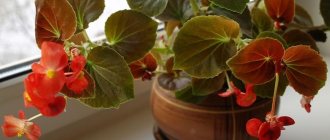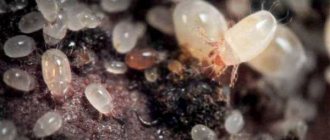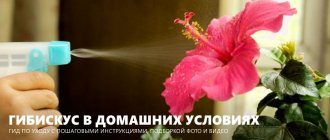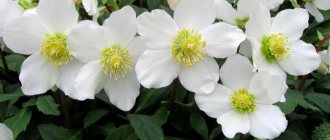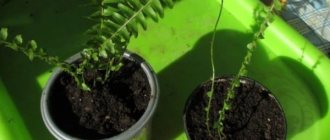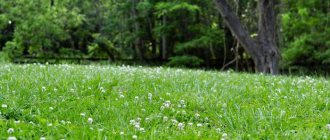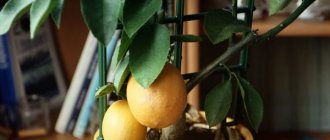The most unpretentious begonias are root begonias. They do not need to have a rest period like tubers. However, the roots require care all year round. They are fed in winter, but less often than in summer; they are pruned in spring. Regardless of the type, all begonias grow well and delight with their decorative properties in high humidity in combination with unsalted soil. In this regard, there are nuances of watering: as the soil dries out, only in the tray you can avoid spraying the leaves. How to properly care for a flower so that it is as beautiful as in the photo of this article?
Origin of begonia and distinctive features
There are more than 1 thousand species of begonias in nature. The largest number of varieties is found in South America, followed by Asia (India, the Himalayas, Sri Lanka), and western Africa in third place. There is an assumption that Africa is the birthplace of begonias, from here they spread to Asia and America. In the wild, plants are found in humid subtropics and mountains.
Deciduous begonias
The family was first described by the French botanist Charles Plumier. In 1683, under the leadership of the intendant of the French colonies, Michel Begon, he visited the islands of the Caribbean with an expedition. There the scientist discovered plants that were unknown at that time, gave them a description and named them after the organizer of the trip.
The begonias known today differ greatly from each other in size, shape, coloring of leaves and flowers. Some are perennial, others are annual. There are herbaceous and shrubby begonias, with creeping or thickened rhizomes. But there is also something in common that unites these plants into one family.
Characteristics of begonias:
- All types of begonias have an asymmetrical, oblique leaf;
- flowers are monoecious;
- perianths - brightly colored, unequal;
- the fruit with seeds looks like a capsule;
- all begonias grow in approximately the same natural conditions: diffused sunlight, high humidity, temperature +13... +22 °C.
Video: the wealth of types and colors of a flower
Tuberous begonia has gained the greatest popularity among gardeners. In beauty and abundance of flowers, begonias are second only to roses. The plant has a fairly long flowering interval: in open ground it lasts more than four months (from June to September), at home it can last up to six months or more. The plant does not like windy areas and direct sunlight.
No worse than roses
The size of begonia flowers is very diverse: there are varieties with flowers up to 20-25 cm in diameter, however, most have smaller flowers, which compensate for this deficiency with a large number of flowers in inflorescences.
A variety with a large number of flowers in inflorescences
The shape of the flower is also very diverse. A separate group includes ampelous begonias, which have a characteristic inflorescence shape and long branching shoots. There are also ever-flowering begonias, which are unique flowering record holders - it lasts up to 8 months for these plants.
Ampel beauty
The main difference between club begonia is the presence of a large rhizome, from which fairly thick stems with heart-shaped leaves grow. The stems are covered with fluffy petals.
Tuberous
Which variety should I choose?
Wanting to decorate their home, many choose hanging varieties of flowering begonias due to their attractive appearance and unpretentiousness. The plant is strewn with double and semi-double flowers of bright colors, which are located on long peduncles. The flowering period occurs in spring-autumn. Since the culture is characterized by long hanging shoots, it looks very impressive on a floor stand or in a hanging pot. The most popular varieties are: Girl, Kristy, Kati, Rocsana and Chanson.
Large-flowered begonia Camellia is also considered quite popular: its appearance and description will be discussed below. Belongs to a variety of tuberous type. Double flower. The height does not exceed 30 centimeters. The subshrub is characterized by emerald foliage, which is shaped like hearts. The edges of the leaf blade are uneven and jagged. The inflorescences are white and have pink spots. Camellia is widely used for landscaping public gardens and parks. It is often grown on loggias and balconies.
Features of early planting
Begonia is quite easy to breed, but there are a number of rules, failure to comply with which can lead to the death of the plant. One of them is the conditions under which the tubers are kept.
Even short-term hypothermia below +5°C can cause the top of the tuber to die, so its transportation and storage must take this circumstance into account.
The begonia tuber has a pronounced asymmetry: one of its sides is convex, the other is concave. Planting in the ground is allowed only with the convex side.
Preliminary germination of tubers should be carried out from February to the end of April. In this case, it is best to plant the tubers in separate small pots filled with peat substrate; Before planting, it is recommended to slightly moisten the peat. Having soil so rich in nutrients, the begonia will quickly develop and begin to form healthy leaves.
Planting should be done at room temperature. Immediately after this, the tuber should be watered moderately. Stagnation of water during further cultivation should not be allowed, however, the soil should not be allowed to dry out.
Tuber planted in peat substrate
How to properly store tubers
In winter, begonia tubers can be stored in an apartment or basement. Each of these options has its own nuances.
Storage in the apartment
In an apartment, it is recommended to store flower tubers in a cool place. This could be a place under a window or balcony door. The temperature should be in the range from 0 to 9 degrees.
There are 3 main storage options:
- In a box or crate. The tubers are sprinkled with sand, sawdust or peat.
- In pots. The container is transferred to a cool place, and all the green part is cut off. The soil needs to be watered periodically, it should remain slightly moist.
- In a refrigerator. The tubers are thoroughly dried, placed in bags with holes and wrapped in paper. They are best stored in the bottom of the refrigerator with fruits and vegetables.
When stored in pots there is a risk of rotting. To avoid this, the soil should be watered through a tray.
Basement storage
The basement should be dry and cool. A cellar for storing begonias is not suitable. It contains high humidity and planting material can begin to rot. The tubers are placed in a box or box. They must be covered with sawdust or sand.
Begonia transplant
As soon as the begonia sprouts reach a height of 5-6 cm, the plant must be transplanted into a larger pot. The minimum diameter of a pot for begonia at home should be at least 25 cm. Begonia tolerates replanting well, so at this stage there should not be any special problems.
A larger pot will allow the plant to begin its growing season in full: during the second month, the begonia will produce a large number of new leaves, and the first ovaries of flower buds will appear. Further transplants should be made in two cases: either when the root system of the begonia grows too much, or if it is necessary to plant the plant in open ground. This should be done as soon as weather conditions allow (temperature 15-20 °C).
Plants in need of replanting
The procedure for replanting a plant with a formed root system is somewhat more complicated: the flower must be completely removed from the pot and the roots must be cleared of soil. After this, they are treated with a solution of potassium permanganate by immersing them in a weak (0.1 g per 1 liter of water) solution. The residence time in the solution is no more than half an hour.
After disinfection of the plant, rotten and dried roots are cut off, and the cut areas are treated with charcoal powder. At the bottom of the pot you need to put drainage made of small crushed stone or large eggshells. The first two weeks after transplantation, the plant must be kept in the shade and provided with abundant watering.
Begonia transplant process
Features of transplanting into open ground
The place where begonias are planted must meet certain requirements: it must be an area protected from winds and direct sunlight. The ideal option is a semi-shaded area on the north side of the garden.
The planting rule is very simple - it is necessary to place begonia bushes at a distance of at least 30 cm from each other. Since the plant is decorative, it can be used for planting entire flower beds. The height of begonia reaches 35 cm, that is, this plant occupies a mid-level niche in flower beds.
After planting, it is recommended to mulch the soil with sawdust or small light stones (for example, expanded clay). Mulching helps the soil retain moisture longer and relieves the owner of the need to loosen the soil.
Flowerbed with perimeter of begonias
Lighting for begonias
Begonia prefers to grow in shaded areas or in areas where there is indirect sunlight. Contact with direct rays of the sun is unacceptable.
Begonia also does not tolerate changes in light: if the germination of the tuber and the beginning of the plant's growing season took place under the same lighting conditions, then when they change, the plant may begin to wither. In the house, the optimal location for the flower will be all well-lit window sills, except the southern one.
On the north side of the house in a warm climate
On southern window sills, if specialized shading or light diffusion measures are not applied, burns may appear on the leaves.
On a shaded windowsill
Plant care
Begonia feels good at temperatures from 18 °C to 22 °C. Seedlings require higher temperatures - from 20 ° C to 25 ° C. The soil should be neutral or acidic.
The temperature in the room with indoor begonias should not fall below +18 ° C, and the soil should not be alkaline.
Before transplanting into stationary pots, begonia seedlings require fertilizing once every two weeks with complex fertilizers. You can prepare them yourself from a mixture of nitrogen and potassium fertilizers, but it is better to purchase special fertilizers for violets and begonias, sold at any flower shop.
An adult plant is fertilized twice:
- nitrogenous fertilizers during the active growing season
- a mixture of phosphorus and potassium fertilizers before flowering
It is best to apply fertilizers in the evening, and two hours before applying them, the soil should be slightly moistened. After applying fertilizers, the plant is also lightly watered.
After flowering ends (as a rule, this occurs in late autumn), indoor begonias need light feeding with potassium fertilizers.
During flowering, the plant requires supports for the stems on which the flowers are located. This is due to the large number of flowers in the inflorescences or the relatively large mass of the flower compared to the stem.
With the onset of cold weather, garden begonias should dig up the tubers, clean and wash them, and then dry them for about a week in a cool, shaded room. Before drying, it is necessary to cut the stem no less than 3 cm from the tuber. After which the tubers are stored until February at temperatures of at least +5 °C. Once a month, the substrate on which stored begonias lie must be moistened.
Storing the tuber for storage
Features of watering
To maintain the plant in good condition, it must be properly watered. Begonia at home requires special attention. In the summer, drying out is not acceptable for a plant with massive stems and leaves.
In normal temperature ranges, begonias need to be watered once every 2-3 days, however, in hot weather, watering should be done every day. This is especially important during the flowering period.
The soil should be well moistened, however, there should be no stagnation of water. In this regard, pot drainage plays a significant role. It should reach about a quarter of its height. The best element for draining adult begonias is expanded clay.
Drainage system
It is best to water the plant with rain or settled water. Before watering, you need to make sure that the soil in the pot is almost completely dry.
Water should not get on the plant leaves or flowers. If this happens constantly, the leaves will begin to rot.
Some types of begonias can be sprayed to humidify the air. However, this should not be done for stems and leaves with a “velvety” texture and for any plants during flowering.
Recommendations for growing at home
Depending on the species, begonia pleases with either beautiful flowering (decorative flowering) or interesting color and unusual leaf shape (decorative deciduous). The photo clearly shows the difference between these two types.
How to properly care for your home begonia so that it pleases the eye with its abundant flowering? To do this, you should follow some recommendations for growing it indoors.
Begonia propagation
This process can be carried out in three ways:
- seeds
- cuttings
- dividing the tuber
The first method is almost never used due to its labor intensity, so begonia propagation at home is most often carried out by vegetative methods.
Propagation by cuttings
For this purpose, cuttings from stems or leaves are prepared; The optimal time for cutting cuttings is early May. It is best to use whole leaves as cuttings. The prepared cuttings are installed in a substrate of peat-sand mixture. Sometimes cuttings are germinated in water before being placed in the substrate.
It would be a good idea to treat the cut of the cutting with any rooting agent. Watering the cuttings should not be too frequent - approximately once every 7 days. More frequent watering leads to rotting of the cuttings.
After about a month, the cuttings take root and can be transplanted into a separate pot.
Stem cutting
Reproduction by tuber division
This is the main method of propagating begonias when caring for them at home. In this case, young tubers are used, which should be germinated for no more than 1 week before dividing (until the first shoots appear).
Division is done by cutting the tuber into pieces with a knife, so that each part of the tuber has a sprout and a root. The cut site is treated with charcoal or sulfur. After this, the tubers are placed in a substrate (preferably pure peat), but they are buried at about half the depth.
Separating begonia tubers
What is necessary?
Before proceeding directly to transplanting begonias, it is important to stock up on all the necessary components for this. These include several components
- Pot. It should not be too large and spacious. For young plants, you need to select containers 3-4 centimeters larger than the previous pots in which they are sold in stores.
- High-quality and suitable soil mixture. For begonia, the optimal mixture is a combination of peat, humus, turf and plain soil. All components must be taken in equal proportions.
- Good drainage. You should never forget about it if you want to create the most comfortable living conditions for the plant. For this purpose, various materials are used, for example, expanded clay, tiles, crushed stone or polystyrene foam cut into cubes.
These are all the necessary components that will be needed to properly transplant the begonia into a new container.
Problems with the plant
Begonia itself is a rather whimsical plant that requires careful care. Some simple begonia problems can be solved by paying close attention to the plant's appearance:
The presence of medium-sized brown spots on the leaves indicates that the plant has received burns and requires urgent transfer to a shaded area. If, after moving the plant into the shade, these spots do not go away, then the plant needs to be fed or the watering regime changed. Similar manifestations can occur with either excess or lack of nutrition or water.
Leaves that dry and subsequently fall off are a sign of excessive dry air around the begonia. This often happens at the end of winter, as warm air from heating radiators dries out moisture. In this case, humidifying the air with a spray will help. If the plant's stems rot, this indicates excessive watering. The watering regime should be reduced, while removing damaged parts of the plant.
The appearance of spots on the leaves
Pests
A plant weakened by improper care may lose its immunity. The consequence of this unpleasant process will be the appearance of pests. Powdery mildew can cause the greatest harm to begonias. This dangerous fungus can destroy the entire plant within a few days.
Fortunately, powdery mildew is vulnerable to even the weakest fungicides. Even such a simple folk remedy as a solution of garlic juice in warm water can easily cope with this begonia disease. To avoid re-infection of the plant, watering should be significantly reduced and the soil should be loosened regularly. It would also be a good idea to ventilate the room to get rid of stagnant air.
Another begonia pest is the common aphid. There is nothing left to do except remove the aphids manually. In this case, you can either collect aphids or treat the leaves with an alcohol solution. There are also special solutions to combat aphids, which are sold in garden stores.
Aphids on houseplants
Sometimes, with low air humidity, the plant can be attacked by spider mites. They fight it with a chamomile decoction or a simple solution of soap in water.
Pests
If no measures help to revive the plant, it is possible that parasites have appeared in the soil and are slowly eating the roots. In this case, take out an earthen ball with a rhizome, wash it in a solution of potassium permanganate and replant it in new soil.
The most common enemies of begonias are nematodes, spider mites, aphids, and thrips. Actellik is used against them, an insectoacaricide that simultaneously kills ticks and insects on shoots and in the ground.
Important! Spider mites are not insects, so conventional insecticides do not work against them.
At the same time, you should inspect the rest of the plants in the room. If the pests have managed to move in, all crops will have to be treated with Actellik. Spraying is carried out, the effect of which lasts 12 days, after which the treatment is repeated. It is permissible to carry out no more than two sprayings.
How to get rid of most types of weeds very quickly? Weeding will no longer be needed. New development from agronomists - here
